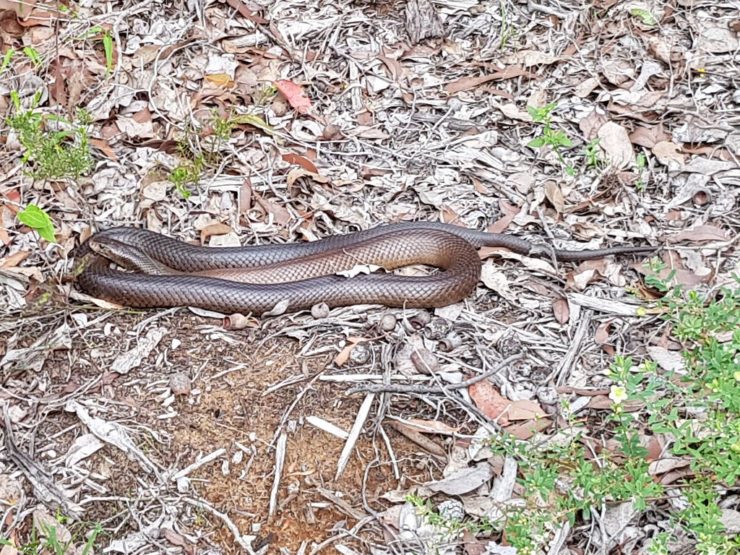Snakebite first aid 101

Snakebite first aid 101
Posted on
As hikers, we don’t like to think about the dangers that lurk in the Australian bush. When we do, though, snakes are probably the first thing that comes to mind.
The good thing is that your chances of actually suffering a snakebite on the trail are pretty low. Believe it or not, you’re more likely to be struck by lightning. The old saying, “snakes are more afraid of you than you are of them”, is truer than you think. For the most part, when someone’s bitten in Australia it’s because they were trying to catch or kill the snake.
So, before we get into what to do if you’re bitten by a snake, I’ll state the glaringly obvious – you’re better off not being bitten in the first place. Here are a few ideas to help you avoid a snake bite:
- Watch where you’re putting your feet. If you accidentally step on a snake, it’ll likely try to defend itself. Can you blame it? If you need to look at your map or your phone, stop walking. If you come across an obstacle on the track (eg. a log or a large rock), step onto it rather than over it. That way you can see what’s on the other side.
- As with any wildlife you stumble across in the bush, if you see a snake, just leave it alone. Observe from afar and give it the time and space it needs to get out of your way without scaring it any more than you already have.
- Cover your legs with either long pants or, better yet, gaiters. Anything you can put in between your skin and a snake’s fangs will decrease the likelihood of envenomation. The same goes for your feet – sturdy hiking shoes or boots are far more protective than those old Dunlop volleys you love telling people you wear on your hikes.
Unfortunately, no matter how much you protect yourself and how aware you are of where you’re stepping, accidents do happen. If you think you’ve been bitten, even if it’s through clothes or gaiters, assume that you’ve been envenomated but try not to panic. I know, I know… That’s easier said than done, but most people who are bitten by snakes fail to follow proper snakebite first aid. This is probably because they panic, or they just don’t know what to do. I’ve got you covered on the latter problem.
- The first thing you need to be aware of is that the venom moves through your lymphatic system, not your bloodstream. Any movement you make will encourage the venom to move more quickly through your body, so when you realise you may have been bitten, stop moving. Obviously, if the snake is still nearby, you’ll need to move far enough away from it to be safe. Then sit down and lean against something (or lie down).
- Call for help. If you have mobile reception, dial 000. If not, activate your emergency communication device (eg. a Personal Locator Beacon). If you don’t have phone reception, you’d better hope you’re hiking with someone who can run for help or you’re on a busy enough trail that someone will come along soon who can help.
- Now it’s time to treat the bite. Forget what the movies have taught you about sucking the venom from the wound. Instead, you need to apply a splint and a broad pressure bandage (or a Setopress bandage). Any rigid object can be used as a splint, and if you don’t have a bandage, you’ll have to make one from whatever material you have available (eg. a t-shirt or a pair of pants).
- The bandage should be applied from the fingers or toes towards the torso, as far up the limb as possible.
- Bandage firmly but not so firmly that it stops blood circulation.
- Make sure the fingers or toes aren’t bandaged so that you can still check that circulation isn’t cut off.
- There’s no need to remove clothing, just bandage over it.
- The bandage can be used to attach the limb firmly to the splint.
- In the rare event that the bite isn’t on a limb, apply pressure to the bite but make sure you’re not restricting chest movement.
- Research done by the University of Newcastle suggests that angina ointment rubbed around the bite area may also slow the movement of venom through the lymphatic system, so this might also be a valuable addition to your hiking kit.
Now that you know what you need to do if you do get bitten and, more importantly, how unlikely it is, I hope you’ll be a bit less stressed next time you hit the trail. We’re actually extremely lucky that we can share our wilderness with such beautiful creatures. Next time you see one, maybe with a bit more knowledge under your belt you’ll be able to take the time to observe it from a distance and see for yourself how incredible they are.
Neil Fahey
Guest blogger from the bushwalkingblog



